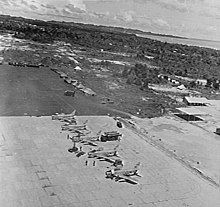- Yes
- No
Hi and welcome to my 80th suggestion, which is about an potential RMAF Sub-TT, hope you like it. ![]()
I can already say in advance that this Sub-TT is relatively small and not super spectacular, but still offers one or two interesting vehicles, which can be part of an ASEAN (Sub-) Tech Tree.
First of all:
- Feel free to share more Information and / or correct me if something is wrong
- Discuss respectfully, any aggressive kind or verbal abuse will be reported, the Forum rules also apply here
- Please, do not start political or personal discussions
The history of military aviation in the former British Malaya and British North Borneo is closely linked to the presence of RAF bases in Singapore, which was part of Malaysia until 1965. Before World War II, the Royal Air Force (RAF) established several bases in what is now Malaysia, some of which were not put into operation until 1941. However, these had to be evacuated soon after the start of the Japanese invasion. After the war, the reconstruction of flight operations began, parallel to the political changes in the region.
After the end of World War II, the decolonization of Southeast Asia began. In 1948, the Federation of Malaya was formed, and the RAF and the Royal Australian Air Force (RAAF) were deployed to fight communist guerrillas as part of the Malayan Emergency. In February 1953, the RAF established its first helicopter unit, the 194th Squadron, in Kuala Lumpur. Using Dragonfly and later Sycamore helicopters, the squadron played a key role in jungle warfare, where helicopters offered clear advantages over short take-off aircraft. RAF operations officially ended in 1960, three years after the Federation of Malaya gained independence in 1957.
The external security of the young state was initially provided by the United Kingdom under the Anglo-Malayan Defence Agreement. Between 1963 and 1966, the British supported Malaya in the conflict with Indonesia, which was triggered by North Borneo’s accession to the Federation of Malaysia. The RAF was deployed on both the Malay Peninsula and North Borneo, particularly with helicopters such as the Whirlwinds of 230 Squadron and bombers operating from Singapore.
With the withdrawal of British forces from Asia in 1971, the Five Power Defence Arrangements (FPDA), a defence agreement between Malaysia, Singapore, Australia, New Zealand and the United Kingdom, came into force.
The Malayan Auxiliary Air Force, which was established during British rule, was merged into the Royal Malayan Air Force (Tentera Udara Diraja Persekutuan) on 2 June 1958. It took over RAF Kuala Lumpur (Simpang Airport) in 1960. On 16 September 1963, the day Malaysia was founded, it was renamed the Royal Malaysian Air Force (RMAF) or Tentera Udara DiRaja Malaysia (TUDM). Many of the early members of the RMAF had previously served in the RAF.
In the early years, the RMAF played a more support role, with only liaison aircraft and helicopters. After 1963, the first transport aircraft, including the Herald and the Caribou, entered service. The first combat aircraft, ten Australian Sabres, were taken over by the RAAF in 1969 and stationed at RAAF Base Butterworth. However, these aircraft were decommissioned in 1972.
After the British withdrew in 1971, Australia helped secure Malaysian airspace until 1983, notably by stationing a Mirage IIIO squadron in Butterworth. In the 1970s, the RMAF modernized its fleet and received, among other aircraft, F-5E Tigers and A-4 Skyhawks, which were later replaced by modern fighter aircraft such as the MiG-29 (9.12B), BAE Hawk 108 / 208 and F/A-18D, of which most are still in service today.

The RMAF Air Sub-Tree is quite small, which is because Malaysia does not have as many suitable options as other nations from Southeast Asia, but among these few there are also unique modifications that are worth integrating into the game.
In addition, not all possibilities are represented in the following sub-tree. I have left out some because it is either not verifiable whether variant XY was ever used by the RMAF, they are pure C&P, have no verifiable armament or are not balanceable. These include; MB-339CM, CL-41G, F-5E / F, MiG-29 (9.12B) (initial delievery), F/A-18D (initial delievery). If you have further information on CL-41G or MB-339CM, please let me know in the comments (along with sources), in case these are viable for the game and can be added to the Tech Tree.
Although the FA-50M has been ordered but not yet built and put into service, I have added it as a possible future option - another possible future option is the Su-57E.
Rank 5
Aermacchi MB-339A
Two seat Combat-Trainer with good medium CAS armament and 30mm guns pods for self-defence.
Characteristics:
- Crew: 2
- Powerplant: 1x Rolls-Royce Viper Mk. 632
- Thrust: 17,8 kN
- Maximum speed: 898 km/h
- Rate of climb: 34 m/s
- Maximum g-load: +8g / -4g
Armaments:
- 2x 30mm gun Pods
- 2x FFAR Pods
- ?x Mk.82
Rank 6
CAC CA-27 Mk.32 Sabre
The CA-27 Mk.32 has two 30mm cannons, 162 rounds each, as its main armament, as well as the ability to carry two AIM-9B Sidewinder missiles; although these have not been seen in RMAF service, the possibility of using them is there. For air-to-ground combat, the Sabre has a small selection of unguided rockets and bombs.
Suggestion Link: CA-27 Mk.32 Sabre - RMAF Butterworth’s old Gate Keeper
Characteristics:
- Crew: 1
- Powerplant: 1x Rolls-Royce Avon Mk.26
- Thrust: 3.289 kgf
- Maximum speed: 1.119 km/h
Armaments:
- 2x 30mm guns
- 2x AIM-9B
- 2x 100ib AN-M30
- 2x 250 lb AN-M57
- 2x 500 lb AN-M64
- 2x 1,000 lb AN-M65
- 2x BLU-1
- 30x RP-3 3-inch
- 20x HVAR 5-inch
- 20x Matra T10 5-inch
- 10x LAU-32
BAE Hawk 108
Combat trainer as a supplement to the Hawk 208, practically a slimmed down version of these.
Characteristics:
- Crew: 2
- Powerplant: 1x Rolls-Royce Adour Mk.951
- Thrust: 28,89 kN
- Maximum speed: 1019 km/h
- Rate of climb: m/s
- Maximum g-load: +8g / -3g
Armaments:
- 1x 30mm gun Pod
- 2x AIM-9P
- 2x AIM-9P-4
- 2x AIM-9L
- ?x Mk.82
- ?x CRV7
Douglas A-4PTM
Refurbished A-4C/Ls and modified under the PERISTA project to meet the needs of the RMAF and partially A-4Ms. Retired in the mid 90’s and replaced by Hawks.
Characteristics:
- Crew: 1
- Powerplant: 1x Wright J65-W-20
- Thrust: 3810 kgf
- Maximum speed: ~1100 km/h
- Rate of climb: ~48 m/s
- Maximum g-load: +8g / -3g
Armaments:
- 2x 20mm Mk.12 Mod 0
- AIM-9J
- AGM-65B
- Various dump bomb and rockets
BAE Hawk 208
Single-seat, light multi-role fighter specifically for Malaysia. Modified to carry AGM-84, four AIM-9 and other armament.
Characteristics:
- Crew: 1
- Powerplant: 1x Rolls-Royce Avon Mk.207
- Thrust: 4,602 kgf
- Maximum speed: 1144 km/h
- Rate of climb: 40,7 m/s
- Maximum g-load: +8g / -3g
Armaments:
- 1x 30mm gun Pod
- 4x AIM-9P
- 4x AIM-9P-4
- 4x AIM-9L
- ?x AGM-84
- ?x Mk.82
- ?x CRV7
Rank 7
Northrop RF-5E
The F-5E with a redesigned nose to accommodate reconnaissance equipment. Unknown A2G armament, one gun removed, AIM-9P-4 capability.
Characteristics:
- Crew: 1
- Powerplant: 2x General-Electric J85-GE-21
- Dry thrust: 2x 16 kN
- Afterburner thrust: 2x 22 kN
- Maximum speed: 1.743 km/h
- Rate of climb: 175 m/s
- Maximum g-load: +9g / -3g
Armaments:
- 1x 20mm M39A3
- 2x AIM-9P
- 2x AIM-9P-4
KAI FA-50M (Block 20M) (Future Addition)
KAI’s FA-50 Block 20 modified for RMAF needs. Expected to enter service in 2026. Intended to replace Hawk 208s in their role as support fighters. No known plans for BVR capability. (Subject for more research.)
Characteristics:
- Crew: 2
- Powerplant: 1x F404-GE-102
- Dry thrust: 53.07 kN
- Afterburner thrust: 78.7 kN
- Maximum speed: Mach 1.5
- Rate of climb: 198 m/s
- Maximum g-load: +8g / -3g
Armaments:
- 1x 20mm M61A1
- AIM-9
- GBU-12
- JDAM
- AGM-65G
- Mk.82
Rank 8
Mikoyan-Gurewitsch MiG-29N Fulcrum-A
Initial delievered MiG-29 (9.12B) were retrofitted with a in-flight refuel probe and re-designated MiG-29N. Identical to current in-game MiG-29 (9.12)s, no internal Jammers.
Characteristics:
- Crew: 1
- Powerplant: 2x Klimov RD-33
- Dry thrust: 2x 50 kN
- Afterburner thrust: 2x 82 kN
- Maximum speed: 2.450 km/h
- Rate of climb: 330 m/s
- Maximum g-load: +9g / -3g
Armaments:
- 1x 30mm GSh-30-1
- 2x R-27(E)R1
- 2x R-27(E)T1
- 6x R-73E
- A2G identical to MiG-29A in-game
Sukhoi Su-30MKM Flanker-H
Based on Su-30MKI, modified to meet the RMAF needs by adding additional 3rd party IFF, MAWS and LWS systems, a DAMOCLES targeting pod and GBU-12 laser-guided bombs.
Unkown modifications during mid-life overhauls.Suggestion Link: Sukhoi Su-30MKM Flanker-H - When East meets West in Southeast Asia
Characteristics:
- Crew: 2
- Powerplant: 2x Saturn AL-31FP
- Dry thrust: 2x 79,4 kN
- Afterburner thrust: 2x 122,54 kN
- Maximum speed: 2100 km/h
- Rate of climb: 230 m/s
- Maximum g-load: +9g / -3g
Armaments:
- 1x 30mm GSh-30-1
- 8x R-27(E)R1
- 2x R-27(E)T1
- 6x R-73E
- 10x RVV-AE / -SD
- Kh-29TE
- Kh-31A/P
- GBU-12
- …
McDonnell-Douglas F/A-18D (25X) Hornet
Initial F/A-18D were upgraded with 25X Software to get closer to Super Hornet, which also enabled to use of JDAM series bombs, AIM-9X Block 2, JHMCS and more. The IFF and other systems were improved and the Cockpits received new replacement parts.
Suggestion Link: Boeing F/A-18D (25X) Hornet - RMAF Butterworth’s Black Tebuan
Characteristics:
- Crew: 2
- Powerplant: 2x General-Electric F404-GE-402
- Dry thrust: 2x 53,3 kN
- Afterburner thrust: 2x 79,0 kN
- Maximum speed: Mach 1,8
- Rate of climb: 254 m/s
- Maximum g-load: +9g / -3g
Armaments:
- 1x 20mm M61A1
- 10x AIM-120C-5
- AIM-9M
- AIM-9X
- AGM-84A/D
- AGM-65G
- GBU-12
- …
Thanks for your time, hope you liked it ![]()
[Will add more if there are some (more) important / declassified things]
[PM or comment if a Link or Picture isn´t working]
Sources:
Links
Malaysian CAC Sabres
transport transport | vip vip | training training | 1990 | 3652 | Flight Archive
The Douglas A-4PTM Skyhawk – Peculiar To Malaysia! – Aces Flying High
A-4 Skyhawk Production History | The Skyhawk Association
Royal Malaysian Air Force Skyhawks | The Skyhawk Association
Douglas Skyhawks Which Were Peculiar To Malaysia? | Travel for Aircraft
https://www.malaysiandefence.com/first-macchi-mb339a-at-rmaf-museum/
Malaysia orders MB-339CD trainers | News | Flight Global
https://www.malaysiandefence.com/mrca-fulcrum-and-retirement/
Books / Other:
Douglas A-4 Skyhawk: Attack & Close-Support Fighter Bomber - Jim Winchester (2005)
Mikoyan MiG-29 Fulcrum - Multi-role Fighter - Gorden E. (1999)
Famous Russian Aircraft Mikoyan MiG-29 - Yefim Gordon (2006)
Sukhoi Su-30 Super-Manoeuvrable Family: Su-30MKI / MKM / MKI (A) / SM - Hugh Harkins (2016)
Capsula Espacial N° 87 - Northrop F-5 Freedom Fighter/T-38 Talon - Juan Biagi (2023)
List of Suggestions of ASEAN region





























